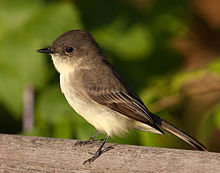Phoebe (bird)
| Phoebes | |
|---|---|

| |
| Sayornis phoebe | |
| Scientific classification | |
| Kingdom: | Animalia |
| Phylum: | Chordata |
| Class: | Aves |
| Order: | Passeriformes |
| Family: | Tyrannidae |
| Genus: | Sayornis Bonaparte, 1854 |
| Type species | |
| Tyrannula nigricans Swainson, 1827
| |
| Species | |
|
See text. | |
The genus Sayornis is a small group of medium-sized insect-eating birds, known as phoebes, in the tyrant flycatcher family Tyrannidae.
Taxonomy[]
The genus Sayornis that was introduced by the French naturalist Charles Lucien Bonaparte in 1854 with black phoebe (Sayornis nigricans) as the type species.[1][2] The genus name is constructed from the specific part of Bonaparte's name for Say's phoebe, Muscicapa saya, and Ancient Greek ornis meaning "bird".[3] The English Phoebe is a name for the Roman moon-goddess Diana.[4]
Description[]
This section does not cite any sources. (January 2020) |
They are native to North and South America.
They prefer semi-open or open areas. These birds wait on a perch and then catch insects. Their nest is an open cup sometimes placed on man-made structures.
They often slowly lower and raise their tails while perched.
Species[]
The genus contains three species:[5]
| Image | Scientific name | Common Name | Distribution |
|---|---|---|---|
 |
Sayornis phoebe | Eastern phoebe | eastern North America |
 |
Sayornis nigricans | Black phoebe | United States, Mexico and Central America, and parts of South America |
 |
Sayornis saya | Say's phoebe | United States and Canada |
References[]
- ^ Bonaparte, Charles Lucien (1854). "Notes sur les collections rapportées en 1853, par M. A. Delattre, de son voyage en Californie et dans le Nicaragua". Comptes Rendus Hebdomadaires des Séances de l'Académie des Sciences. 38: 1–11, 53–67, 258–266, 378–389, 533–541, 650–665 [657].
- ^ Traylor, Melvin A. Jr, ed. (1979). Check-List of Birds of the World. Volume 8. Cambridge, Massachusetts: Museum of Comparative Zoology. p. 147.
|volume=has extra text (help) - ^ Jobling, James A (2010). The Helm Dictionary of Scientific Bird Names. London: Christopher Helm. p. 349. ISBN 978-1-4081-2501-4.
- ^ "Phoebe". Oxford English Dictionary (Online ed.). Oxford University Press. (Subscription or participating institution membership required.)
- ^ Gill, Frank; Donsker, David, eds. (2019). "Tyrant flycatchers". World Bird List Version 9.2. International Ornithologists' Union. Retrieved 29 June 2019.
- Bird genera
- Tyrannidae
- Birds of the Americas
- Taxa named by Charles Lucien Bonaparte
